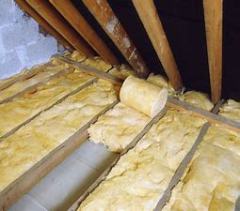Roof and Loft Insulation
Loft insulation types
Bat or blanket loft insulation This is probably the most common type of insulation. It is available in rolls of foil-backed felt, rockwool, hemp, glass or mineral fibre. Pros: Straightforward to install yourself. Some brands use recycled glass or sheep’s wool (which is non-irritant). Good for insulating accessible spaces such as exposed wall cavities. Cons: Some materials can irritate the skin, so you'll need to wear proper protection. Sheep’s wool is a more expensive insulation option. Rolls of blanket can be too bulky to fit in small spaces or around obstructions.
Loose-fill loft insulation This is made from a variety of granular or lightweight materials such as cork granules, mineral wool or cellulose fibre. Greener types of loose-fill insulation include recycled newspaper. Pros: Fits easily between irregularly spaced joists or around obstructions. It is useful for topping up existing insulation in attics. Cons: Can come loose in draughty lofts. Safety equipment and protective clothing are needed during installation.
Sheet loft insulation Sheet insulation is designed for insulating the sloping sides of the roof and comes in the form of rigid boards. Some insulation boards are available with a fire-resistant, moisture-resistant or decorative covering. It can be ordered pre-cut to specific sizes, usually at an additional cost. Pros: Greener sheet loft insulation options include cork, straw and wood board. It is excellent for insulating loft conversions. It can be covered with plasterboard for an attractive finish. Some synthetic sheet materials have a high insulating value per unit thickness. Some boards come with their own system of attachment. Cons: synthetic sheet insulation materials use large amounts of energy during production. They can be more expensive than other types of loft insulation.
Blown-fibre loft insulation You will need a professional contractor to install blown-fibre insulation - the insulation is blown into the gaps between joists. Pros: Quick and easy to install when done by a professional. Greener insulation options include recycled paper wool or hemp. It is ideal for insulating areas where access is difficult. Light and convenient to handle and cut. Cons: Can be more expensive than other types of loft insulation. Not recommended for insulating draughty lofts.
Loft or Roof insulation?
Lofts are usually cheaper and easier to insulate than roofs. But if your loft has been converted into living space, you will have to insulate the roof itself by installing the insulation between the rafters. Generally speaking where the roof space is only used for storage, it is better to lay the insulation between the ceiling joists above the bedrooms.
One reason some people don’t insulate their loft is because of the required 270mm of insulation material over the joists would make it difficult to lay boards on top. But there is a way around this: Insulate between the joists with mineral wool, lay rigid insulation boards on top and wooden floor boarding on top of that. You can buy insulation board that's been pre-bonded to floor boarding to make the job easier. Alternatively, raise the level of the floor so you can fit enough mineral wool beneath the new floor level.
Insulating the sloping ceilings
Most of the original Burlingham properties have a collared roof construction which results in sloping ceilings in the bedrooms. It is essential to insulate these areas of sloping ceilings as well but this can only be achieved by either removing the tiles and sarking felt and installing the insulation from above, or by removing the plasterboard ceiling and installing the insulation between the rafters from below. An alternative would be to pour in some loose fill insulation from the loft space above but the cavities would need to have been filled first.


